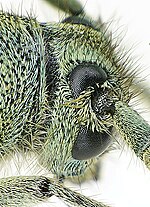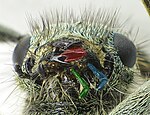Dense-dotted roller collar
| Dense-dotted roller collar | ||||||||||||
|---|---|---|---|---|---|---|---|---|---|---|---|---|

Dense-dotted roller buck ( Opsilia coerulescens ), male |
||||||||||||
| Systematics | ||||||||||||
|
||||||||||||
| Scientific name | ||||||||||||
| Opsilia coerulescens | ||||||||||||
| ( Scopoli , 1763) |
The sealing Dotted roll neck Bock ( Opsilia coerulescens ) is a beetle from the family of the longhorn beetle and the subfamily Lamiinae . It is widespread in Europe and occurs in Crete in the subspecies Opsilia coerulescens cretensis . In the past, Opsilia was listed as a subgenus of the genus Phytoecia and the species is correspondingly described in the literature under Phytoecia coerulescens . Linguistically, there is a risk of confusion with Phytoecia caerulea .
The species name coerulescens from Latin coeruléscens for bluish is misleading, because the beetle is more gray to turquoise in color. The generic name Opsilia is from Altgr. ὄψ “ōps” for “eye” derived, Phytoecia is from old Gr. φυτόν “phytón” for “plant” and οἰκία “oikía” for “apartment” and expresses the fact that the beetle can be found in its host plant.
Characteristics of the beetle
The beetle is black, but appears pale greenish or blue-green to light gray through dense gray to greenish hairs. In addition to the adjacent short hair, it also has long, predominantly black hair on the front part of the body (Fig. 4). It reaches a length of six to thirteen millimeters. The cylindrical body tapers significantly towards the rear in the male, less so in the female.
The head is inclined downwards orthogonally to the body axis (Fig. 1 center) and, viewed from above, appears wider than it is long. The eleven-part antennae are about body length. The compound eyes are not only strongly edged, as is usual with longhorn beetles, but are also completely separated into an upper and a lower part by the deflection of the antennae (Fig. 2). Another important feature is that the upper jaws do not end in one point, as in the other European species of the genus, but taper off in two points (Fig. 5).
The pronotum (Fig. 4) has in the middle and next to the side fall a more thickly haired and therefore lighter-looking longitudinal stripe. In addition to the short blue-green hair, it is loosely protruding black and light-haired. It is wider than it is long and widest behind the middle.
The elytra are wider than the pronotum at the base and, like the pronotum, are dense and irregularly dotted . The label is densely hairy (Fig. 4).
The abdomen is relatively short, shorter than the rest of the body (Fig. 1 below). On the hind legs, the first tarsal link is significantly longer than the following two together (Fig. 3, bottom). In all tarsi, as in the great majority of longhorn beetles, the fourth limb is very small and hidden between the lobes of the third limb (Fig. 3 above).
biology
The adults are found in Central Europe from May to July on the host plants. The species is classified as xerothermophile , so the habitat must not be too humid and not too cool. The habitats given are dry and warm slopes, limestone drifts, steppe heaths, quarries, heather and sandy floodplains . Nevertheless, find data are available from the plain up to an altitude of two thousand meters, preferably the find locations in Central Europe are in hilly and montane locations. In the sun, the adults swarm around the breeding plants at lunchtime at a low altitude.
The larva is polyphagous and develops in various herbaceous plants ( Echium , Cerinthe , Cynoglossum , Anchusa , Symphytum , Lithospermum , Lappula , Lycopsis , ...), in Central Europe mainly in the adder head . The eggs are laid at the base of the host plant. The larva eats its way inside the stem both upwards and downwards into the root. In the fall, it often gnaws a ring near the surface at the base of the host plant. When retreating into the roots, the larva blocks the passage with a coarse nail. The wind then kinks the infected plant at the level of the ring-shaped feeding tunnel. In spring, the imago drills a hole in the stem below the break point. It takes a year to develop.
distribution
The species is reported from almost all of Europe , but it is absent in Great Britain , Denmark , Scandinavia and the Baltic states . In Belarus the incidence is questionable. The beetle is also found in North Africa, Asia Minor and the Middle East. To the east, the distribution area extends far into Asia. It was introduced in Australia.
Importance to humans
In Australia, the species was introduced in 1995 to control weeds against Echium plantagineum .
literature
- Heinz joy, Karl Wilhelm Harde, Gustav Adolf Lohse (ed.): The beetles of Central Europe . tape 9 . Cerambycidae Chrysomelidae . Spektrum Akademischer Verlag, Munich 1999, ISBN 3-8274-0683-8 (first edition: Goecke & Evers, Krefeld 1966).
- Adolf Horion : Faunistics of the Central European Beetles, Bd. XII . Überlingen-Bodensee 1974.
Individual evidence
- ↑ a b Opsilia coerulescens in Fauna Europaea. Retrieved January 27, 2012
- ↑ Opsilia coerulescens cretensis in Fauna Europaea. Retrieved January 27, 2012
- ↑ Heinz Freude, Karl Wilhelm Harde, Gustav Adolf Lohse (ed.): Die Käfer Mitteleuropas . tape 9 . Cerambycidae Chrysomelidae . Spektrum Akademischer Verlag, Munich 1999, ISBN 3-8274-0683-8 (first edition: Goecke & Evers, Krefeld 1966).
- ↑ Sigmund Schenkling: Explanation of the scientific beetle names.
- ↑ Klaus Koch : The beetles of Central Europe . Ed .: Heinz Freude . tape 3 : ecology . Goecke & Evers, Krefeld 1992, ISBN 3-87263-042-3 .
- ↑ a b c Adolf Horion: Faunistics of the Central European Beetles, Vol. XII . Überlingen-Bodensee 1974
- ↑ AA Kirk and AJ Wapshere: “The life history and host specificity of the Echium borer Phytoecia coerulescens [Col .: Cerambycidae]” BIOCONTROL Vol. 24, Number 4 pp. 423-430, doi : 10.1007 / BF02374182 .
- ↑ a b Willis, Kilby, McMaster Cullen Groves: "Predictability and acceptability: potential for damage to nontarget native plant species by biological control agents for weeds" CSIRO Plant Industry and CRC for Australian Weed Management, GPO Box 1600, ACT 2601, Australia as PDF
- ^ "A Good Weed, the Newsletter of The Weed Society of New South Wales Inc." ISSN 1325-3689 as PDF






